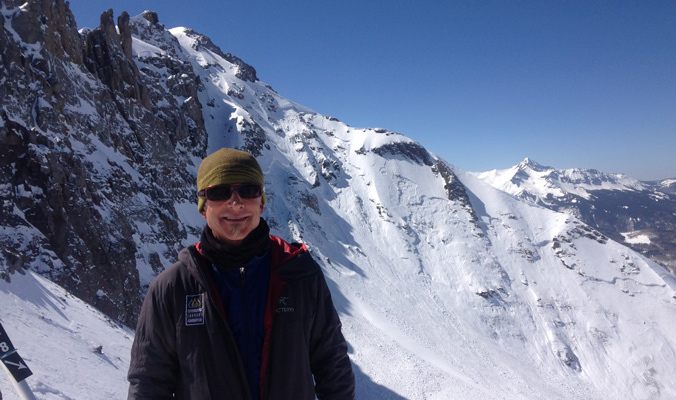For the past three decades, Bruce Engelhard has been teaching avalanche courses and ski guiding in Utah’s Wasatch Mountains. In that time, he’s learned that the mountains always win—but even so, there are ways to manage risk and decision making to keep getting out there and to keep tragedy at bay. And this weekend, Engelhard is sharing that well-honed knowledge at Backcountry Magazine’s Alta Basecamp stop, where he’ll be leading avalanche forecast discussions, beacon practices and a rundown on how to identify red flags in the field.
In the January Issue, and now shared here, Bruce explains his skiing philosophy and how to keep a fresh perspective while staying safe.

Engelhard managing his surroundings. [Photo] Lisa Brenson Engelhard
In the past decade we’ve seen an exponential rise in the number of users in the Wasatch. New technology makes accessing hazardous terrain even easier, and our culture has reached a point where exposure to the extreme through social media is a huge motivating factor for getting into the backcountry. With increasing traffic, we are going to have to see increasing cooperation and learning. If that doesn’t happen, more extreme measures may need to be taken. I want to believe that people can be personally responsible, but that requires cooperation.
The most important mindset to have when traveling in hazardous terrain is a willingness to adjust. The weather and snowpack are always in flux, and you must always be willing to alter your plans with regard to changing conditions.
Teaching students to understand the true value of risk is an overlooked component in education. I’ve lost 13 close friends over the years to avalanche accidents. I want people to understand the consequences and that “getting away with something” is not the right message.
When I share my personal experiences in a class, a student invariably asks, “Have you ever been caught in an avalanche?” It’s an almost automatic question. I’ve had two really close calls in 36 years. The human factor is the central cause for avalanche accidents, and by sharing my mistakes, I hope to foster sound decision making in students.
When your friend looks at you and says, “Hey, I think we should ski this,” your answer should be, “Why?” And if your friend says, “Well, I think it’s OK,” that isn’t enough. That isn’t an answer based in sound judgment and decision making.
When we teach classes, we always close with the question: Where do you go from here? The best way to follow up on a Level One course is to review the curriculum materials that you’ve been exposed to and begin to incorporate them with on-snow experience. And, it’s important to know that this is an on-going process, because no matter what you are learning in life, you can always have a fresh perspective and understanding with each new experience.










Related posts: